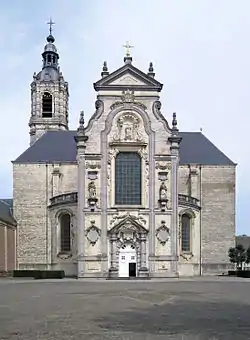Jan Van den Eynde II
Jan Van den Eynde II (Antwerp, 1620 – Antwerp, 1702), was a Flemish architect-entrepreneur. He was the son of Cornelis van den Eynde, another architect-entrepreneur from Antwerp.[1] Jan van den Eynde II was part of the Van den Eynde family of artists, a nephew of Hubert van den Eynde, and brother to Sebastiaen van den Eynde, both renowned sculptors.

Van den Eynde's most famous building is arguably the Averbode Abbey, a peculiar synthesis of Baroque and Gothic with a touch of Renaissance to it, which the Fleming completed between 1664 and 1672. For this project, Van den Eynde was preferred to Lucas Faydherbe.[2][1][3]
Other than an architect, Jan van den Eynde II, who was tied to the nobility,[1] was also a wealthy entrepreneur.[1] Although some of his estate was inherited and thus unrelated to his business, he was worth over 100 000 guilders[1] (for comparison, the price for a decent house in Antwerp was at the time between one and two thousand guilders).[1]
Life
Family
Van den Eynde was born into a renowned Antwerpian family: the Van den Eynde, a clan of artists and entrepreneurs.[4] In the late 17th century, the Van den Eynde became one of the most prominent families of sculptors in Antwerp,[1] forming the Quellinus-Verbrugghen-Willemssens-Scheemaeckers-Van den Eynde consortium, which secured itself monopoly on the sculpture market in Antwerp.[1] Collaboration among the workshops of the aforesaid families in the late 17th century might be the main factor to account for the intricate "unity of style and approaches that have made disentangling of hands particularly difficult for art historians."[1]
Work
Averbode Abbey

In 1664, Van den Eynde was awarded the commission of Averbode Abbey, having been preferred to Lucas Faydherbe, whose plans were rejected.[1][3][2]
Construction began on July 31, 1664.[5][1] The ground-plan of the Averbode Abbey's church combined a centralized cruciform space to the west for the laity with a deep choir, necessary for Norbertine choral services.[6][3] The treatment of space was more emphatic in Averbode Abbey's church than in other Norbertine abbey churches, on account of the happy combination of a radial plan with a very long and axially accentuated choir. The design combined Gothic structural forms, such as ribbed vaults, with Renaissance ornamental details.[3]
The church is considered a peculiar synthesis of Baroque and Gothic.[5]
No dome was built over the central section because in January 1668 one of the major piers collapsed.[3][1] Because two other pillars collapsed thereafter, the fourth pillar also had to be pulled down. Works restarted with more solid material and the building was roofed by the end of 1670.[1] The community inaugurated the new abbey church on July 11, 1672, the feast of St. Norbert. The solemn consecration was not celebrated until June 19, 1681.[1] Van den Eynde also produced the church's sculptures.[2][5][1][6][3]
References
- "Flemish sculpture: Art and manufacture c.1600-1750" (PDF). University College London: 19, 28, 33, 50, 66, 90, 93, 185, 192, 193, 196, 199, 205, 211, 251, 252, 258, 271. 2008.
- "Domein abdij van Averbode". Flemish organization for Immovable Heritage. Retrieved 30 August 2020.
- "Eynde, Jan van den". Oxford Art Online. Retrieved 20 August 2020.
- "Eynde, van den family". Oxford Art Online. Retrieved 20 August 2020.
- "03. Abbey Church". Abbey Church. Retrieved 30 August 2020.
- "Eynde, Jan van den-Norbertine Abbey Church, Averbode". Web Gallery of Art. Retrieved 30 August 2020.